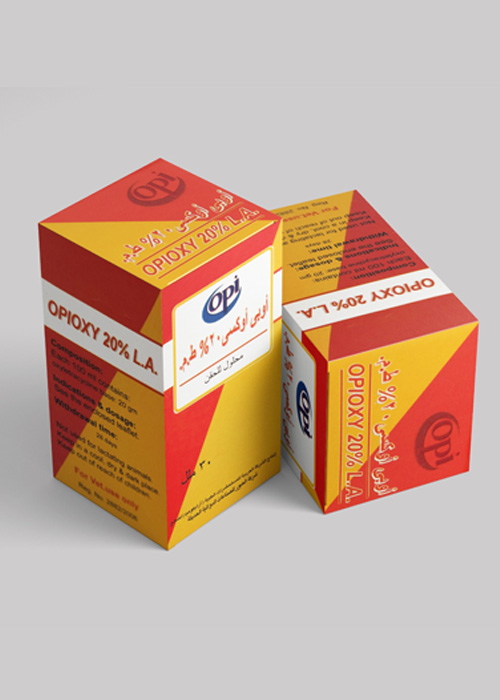OpiOxy 20% L.A
dosage form:Injection
1-Composition:
Each 100 ml contains:
oxytetracycline Hydrochloride 21.6 gm equivalent to 20 gm oxytetracycline
2-Properties:
Tetracyclines generally act as bacteriostatic antibiotics and inhibit protein synthesis by reversibly binding to 30S ribosomal subunits of susceptible organisms, thereby preventing binding to those ribosomes of aminoacyl transfer-RNA. Tetracyclines also are believed to reversibly bind to 50S ribosomes and additionally alter cytoplasmic membrane permeability in susceptible organisms. In high concentrations, tetracyclines can also inhibit protein synthesis by mammalian cells.
As a class, the tetracyclines have activity against most mycoplasma, spirochetes (including the
Lyme disease organism), Chlamydia, and Rickettsia. Against gram positive bacteria, the tetracyclines have activity against some strains of staphylococci and streptococci, but resistance
of these organisms is increasing. Gram positive bacteria that are usually covered by tetracyclines,
include Actinomyces sp., Bacillus anthracis, Clostridium perfringens and tetani, Listeria monocytogenes, and Nocardia. Among gram negative bacteria that tetracyclines usually have in
vitro and in vivo activity against include Bordetella sp., Brucella, Bartonella, Haemophilus sp.,
Pasturella multocida, Shigella, and Yersinia pestis. Many or most strains of E. coli, Klebsiella,
Bacteroides, Enterobacter, Proteus and Pseudomonas aeruginosa are resistant to the tetracyclines. While most strains of Pseudomonas aeruginosa show in vitro resistance to tetracyclines, those compounds attaining high urine levels (e.g., tetracycline, oxytetracycline) have been associated with clinical cures in dogs with UTI secondary to this organism.
Oxytetracycline and tetracycline share nearly identical spectrums of activity and patterns of
cross-resistance and a tetracycline susceptibility disk is usually used for in vitro testing for oxytetracycline susceptibility.
Target species
swine and cattleIndications for use
Indications for use, specifying the target species Cattle (beef, dairy excluding lactating animals, and calves, including preruminating veal calves): Indications: For treatment of pneumonia and shipping fever complex associated with Pasteurella species and Haemophilus species, foot-rot and diphtheria caused by Fusobacterium necrophorum, bacterial enteritis (scours) caused by Escherichia coli, wooden tongue caused by Actinobacillus lignieresii, leptospirosis caused by Leptospira pomona, wound infections and acute metritis caused by Staphylococcus species and Streptococcus species, and anthrax caused by Bacillus anthracis and For treatment of anaplasmosis, severe foot-rot and advanced cases of other indicated diseases. Swine: For treatment of bacterial enteritis (scours, colibacillosis) caused by E. coli, pneumonia caused by Pasteurella multocida, and leptospirosis caused by Leptospira pomona. Sows: as an aid in control of infectious enteritis (baby pig scours, colibacillosis) in suckling pigs caused by E. coli.Dosage & Administration:
| Animal Species | Dose | Route of Administration | |
| Of Active | Of Product | ||
| Cattle | a) 20 mg/kg q48-72h IM if depot form (LA®-200); 2.5 - 5 mg/kg IV q24h; 10 - 20 mg/kg PO q12h. b) For respiratory tract infections: 20 mg/kg IM q3-4 days.IM or SC doses c) For anthrax: 4.4 mg/kg IM or IV daily. d) 20 mg/kg e) 20 mg/kg IM q48h. | a) 0.01 ml/kg q48-72h IM; 0.00125 – 0.0025 ml/kg IV q24h; 0.005 – 0.01 ml/kg PO q12h. b) 0.01 ml/kg IM q3-4 days. IM or SC doses c)0.002 2 ml/kg IM or IV daily. d) 0.01 ml/kg e) 0.01 ml/kg IM q48h. | a) 0.01 ml/kg q48-72h IM; 0.00125 – 0.0025 ml/kg IV q24h; 0.005 – 0.01 ml/kg PO q12h. b) should be injected into the neck and not more than 10 ml per site. IM route may lead to myositis and abscesses. Rapid IV injection may cause collapse. Phlebitis possible with IV dosing. c) do not use in healthy animals recently vaccinated against anthrax as the protective effect of the vaccine may be negated. d) For bovine anaplasmosis: For control: At start of vector season every 21-28 days and extending 1-2 months after vector season ends. To eliminate carrier state Give 20 mg/kg for 4 treatments deep IM in two separate injection sites at 3 day intervals.For treatment of sick animals: Give 20 mg/kg one time. temporary/prolonged protection for rest of herd: Give 20 mg/kg IM as above and repeat at 28 day intervals for prolonged protection. e) For pneumonia 20 mg/kg IM q48h. |
| Swine | a): 4.4 mg/kg b) 6 - 11 mg/kg IV or IM; 10 - 20 mg/kg PO q6h | a) 0.0022 ml/kg. b) 0.003 -0.0055 ml /kg IV or IM; 0.005 – 0.001 ml/kg PO q6h | a) For anthrax IM or IV daily; do not use in healthy animals recently vaccinated against anthrax as the protective effect of the vaccine may be negated. b) 6 - 11 mg/kg IV or IM; 10 - 20 mg/kg PO q6h |






